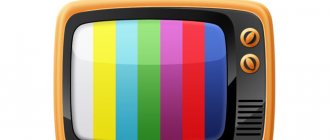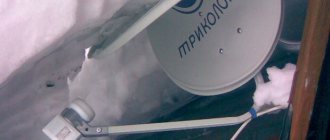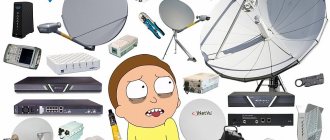Hello, dear readers of the blog Man in the House.Ru. In today's article, as you probably already understood, we will look at the most common causes of malfunctions in the operation of a satellite dish and ways to eliminate them.
It's no secret that you can repair satellite dishes yourself. Calling a specialist for tincture can cost you unreasonably expensive. To save your family budget, let's look at how to repair the satellite system yourself.
Has the converter failed?
The converter itself, if you purchased it from a reliable store, will serve you for a very long time and without complaints. The device is protected from moisture and dust, and if installed correctly, you should not think about it.
If there is no picture on the TV screen, then the last thing you should think about is the converter malfunctioning (with the exception of cases when the converter has been used for more than 5 years).
First, check the remaining points:
- The weather outside is good. In the event of a storm, rain or other bad weather, temporary interruptions in broadcasting are possible.
- The cable from the antenna to the receiver is not damaged.
- The cable connections are securely fastened.
- The smart card is installed correctly.
- The subscription to the main service is active (no debt).
Only after you make sure that all of the above points have been met, you can check the converter.
Dishless TV options
Many subscribers, when offered by an operator to connect “Satellite TV without a dish,” have questions, because usually to access satellite TV you need an antenna tuned exactly to the satellite. In fact, satellite television without a dish means a package of television channels that can be watched via the Internet using a special set-top box or on a TV with Smart TV.
Subscribers can take advantage of various options for watching television without a satellite dish:
- In most regions of Russia, you can watch television using an over-the-air antenna.
- Cable television offers a large list of television channels; you do not need an antenna to connect it, you only need a television cable.
- Fans of satellite broadcasting can watch television programs via the global network using IPTV set-top boxes or on TVs that support Smart TV.
Satellite TV in the country without a dish is an excellent solution for those subscribers who want to watch full packages of channels from the operators Tricolor TV, Telekarta, NTV Plus not only in the apartment, but also in the country.
The package of Tricolor TV channels via the Internet can be watched through certain models of receivers, which need to be configured through the “Menu” and the latest versions of the software installed on them.
NTV Plus subscribers can watch their favorite programs not only without an antenna, but also without a receiver and a smart card. To use this service, you need to download the mobile application and register in your “Personal Account” on the company’s website. After this, certain packages of paid channels will be available to subscribers.
How to check the head (converter) of a satellite dish
The most common problem with satellite devices is the failure of the antenna head (LNB) or DISEQC (switch). This is usually understandable if some TV channels suddenly stop showing. The converter can fail due to precipitation, short circuit and sudden voltage surges.
To check whether this problem is actually due to a converter or disk failure, you must:
- Turn on a channel that has stopped working.
- Unscrew the LNB head from the cable.
- Disconnect the center wire from the receiver and connect to the LNB.
- If in this situation the channel begins to show, then the disk (switch) is faulty. Otherwise the converter is broken.
But, if there is no connection even when replacing the LNB head, then you should look for the reason in the equipment settings.
Terms of Use
Many subscribers who decide to switch from analog television to digital or satellite broadcasting have a number of questions. The main ones are: is it possible to use a satellite dish for digital television, which operator to choose, which of them offers the best conditions and what can be used for free?
Leading companies in the television broadcasting services market have much in common, but at the same time offer users different service options.
You can evaluate and select a suitable operator using the following criteria:
- equipment price and connection cost;
- what free channels are offered;
- monthly subscription fee for additional channels;
- is there a gift deposit;
- promotions and bonuses for new users.
Often, satellite broadcasting operators offer their subscribers several free channels, which are ideal for those who live outside the city, connect television to their dachas, hotels and restaurants. The operator usually does not promise a large number of channels, but the available ones will be broadcast in excellent quality and with good sound. The image received from a satellite is much better than the broadcast one - there is no interference, the picture is bright, the sound is clear and does not hiss.
To get a larger number of new subscribers, almost every operator offers from six months to one year of free broadcasting of the regular package of services. At the end of this period, subscribers independently decide to remain with this company or move to another.
Scheme to check
The test circuit itself is very simple and is based on the fact that a modern LED can be connected to almost any voltage greater than 3 Volts, but only using a current-limiting resistor. The voltage that the disc switches is 13 and 18 volts. This means that we only have to choose, or better yet, calculate a resistor for 18 volts.
R = (V total - V Led) / I
I hope the formula is also not complicated and understandable.
- Vtotal is the maximum voltage that the disk drive switches, let’s take 18 volts.
- V Led — LED supply voltage. Most LEDs are powered by 3 Volts
- I - LED current. We take 20 milliamps
Satellite TV frequency ranges
With the help of satellite television, television programs are delivered via the link layer from the satellite to the subscriber's location.
There are two main ranges used:
- Ku-band with a frequency from 10.7 to 12.75 GHz.
- C - range with a frequency from 3.5 to 4.2 GHz.
Russian satellites broadcast in both bands, while European satellites broadcast mainly in the Ku band. Ku-band has a shorter electromagnetic wavelength, which gives it an advantage over C-band.
The Ku-band is symbolically divided into the following sub-bands:
- The first sub-band is “FSS” with a frequency of 10.7-11.7 GHz.
- The second sub-band “DBS” has a frequency from 11.7 to 12.5 GHz.
- The third subband is called “Telecom” and uses frequencies of 12.5-12.75 GHz for broadcasting.
Ku-converters also come in three variants:
- Single-band, having a frequency of 10.7-11.7 GHz.
- Dual-band with broadcast frequency from 10.7 to 12.5 GHz.
- Tri-band, they are also called “Full Band”, “Wide Band”, “Triple” with a frequency of 10.7-12.75 GHz.
How to check the TV antenna signal
This is a very common error in satellite systems. The equipment seemed to be working normally, but at one point, when you turn on the TV, a window appears on the screen with the words “No signal”.
To check the satellite signal level, go to the receiver settings:
IMPORTANT. When installing new equipment, you can visually inspect the neighboring TV antennas, that is, find out the provider and in which direction they are turned. This way you won’t have to find out the location of a populated area, the name and coordinates of the satellite in orbit and make calculations.
Variants of faults and methods for their elimination.
For transmission equipment. And, depending on what device is used and a certain number and quality of channels are received. Now, in most cases, satellite dishes are used. They are equipped with a certain set of equipment: dish, cable, converter, receiver, and so on.
How to check the performance and technical potential of a television antenna?
But, like any other equipment, this device can fail not only due to mechanical damage, but also if connected incorrectly. In such situations, you need to know how to check a television antenna without resorting to the services of specialists.
There are a number of reasons why a satellite dish on a TV does not work:
- Absence of a power circuit in the receiver-converter flow (both scales are zero, which means there is no contact).
- The antenna is not tuned (there is a signal strength scale, but no quality scale).
- The converter is faulty (the signal strength may be present, but there is no quality scale).
- The memory in the receiver settings has disappeared (during a long “rest”).
First of all, you should pay attention to the TV cable. It should be intact and without any crimps.
- If this is a multi-story building, then you will only have to check the functionality of one end of the cable (with a plug). For this, a multimeter (tester) is used to measure the resistance between the braid and the central core of the wire. A value of several tens of ohms is considered a normal value. If it is greater than or close to “0”, a break or short circuit has occurred. In this case, it is better to find out whether the neighbors have a signal and, if so, then the problem is in the junction box or in the area from it to the plug.
- If this is a private home, then you can check the resistance of both ends of the TV cable. First you need to unplug all equipment from the outlet. Then disconnect the wire from the antenna and from the TV. And in the same way, use a tester to check the braiding and the central core for short circuits. Here, the serviceability of the cable is indicated by an infinite resistance value. But, if you short-circuit the central core and braid, the multimeter should show a value close to “0”.
When the device detects a malfunction, it is necessary, first, to find the weak point of the cable. This usually occurs in places where there are sharp bends, connected sections, or where the wind sways. If everything is fine with the TV cable, the cause of the problem should be looked for elsewhere.
How to set up the Tricolor TV antenna yourself?
Forgot password. Lost your password? Please enter your email address. You will receive a link and will create a new password via email. Testing a converter with a multimeter can hardly be called a correct test. Well, probably if you look closely, changing the probes, you will notice a slight difference in the readings. Which also carries little information. Therefore, the best option is to purchase a cheap SatFinder. Moreover, it is very easy to use. Using it, you can track the signal level and, if necessary, adjust the dish.
Types of converters
Before going to the store, many users ask the question: what kind of converter is needed for Tricolor? In fact, for a given operator, only the type of polarization of the device matters. All other characteristics can be selected at the discretion of the subscriber. Since the satellite signal of this operator in the coverage area is very strong, even the simplest model can provide decent broadcast quality.
And yet, in order to make the right choice, it is worth navigating the main categories of this equipment. Let's talk about its most important features.
Polarization type
All converters present on the modern market are classified depending on the operating frequency range. There are two groups:
- C-band devices (universal) – operate at frequencies from 3400 to 4200 MHz;
- Ku-band devices (circular polarization) - receive a signal from 10700 to 12750 MHz.
Important! Do not pay attention to the “Universal” mark. For Tricolor subscribers, only a circular polarization converter is needed. Tricolor TV can only work with such equipment.
In principle, many home craftsmen propose converting universal-type devices into circular polarization devices. But, although this process is quite simple, it is hardly worth being puzzled by. The cost of the equipment is almost the same, so the conversion will not bring much benefit. And in case of an error when purchasing, it is easier to replace the product from the seller than to bother with updating it.
Noise level
One of the important characteristics is the noise level, or more precisely, the degree of correlation between the interference that occurs after signal amplification and the quality of this signal. The lower this indicator, the clearer the picture will ultimately appear on the user’s TV screen.
For those who are deciding which converter to choose for Tricolor TV hd, we recommend paying attention to models with a characteristic of 0.1-0.2 dB. For normal broadcasting, noisier devices of 3-5 dB will be sufficient.
Number of outputs
Another important classification parameter is the number of outputs a device has. It determines how many TVs can be connected to the antenna at the same time. The simplest option is a converter for Tricolor TV with 1 output. But such models are used very rarely today, since few people have only one television receiver in their home.
Important! Of course, you can always connect another TV via a satellite signal splitter. But it should be understood that the quality of broadcasting will greatly decrease due to interference produced by the divider itself. Therefore, it is better to immediately install a device with a supply of outputs.
For a large family, the best option would be a satellite converter with 4 outputs for Tricolor. Even if at the time of connection there are fewer television receivers in the apartment, it will provide the opportunity to expand the network if desired. The largest converter - with 8 outputs - for Tricolor is most likely suitable for restaurants, hotels and similar organizations.
TV signal level according to GOST
The TV signal level is measured in decibels (dB), taken in relation to the effective voltage (1 µV). The designation looks like this: “dBµV”. In accordance with existing GOST, the value of this parameter should be in the range from 60 to 78 dBµV (these indicators are focused on a package that includes more than twenty programs). The optimal level of a television signal, at which the input signal-to-noise ratio has acceptable values (26 dB), is an indicator of the sensitivity of the television receiver. This parameter is specified in the device passport. Modern TV receivers are designed for a minimum input signal:
- 32 dBmV in the meter range;
- 37 dBmV in the UHF range.
Taking into account the fact that acceptable image quality is observed only at a signal level value that exceeds the receiver sensitivity rating by 20 dB, this value at the input of the receiving equipment should vary in the range of 52-57 dBmV.
In addition to this indicator, the signal characteristics are seriously influenced by such parameters as the ratio of signal to noise levels, as well as the level of intermodulation (nonlinear) distortion. Typically, such complex measurements are not carried out by specialists, but, nevertheless, the quality of the image largely depends on them.
According to existing standards (GOST [2.3]), the value of these parameters should not exceed:
- -72 dB/mW (70 µV) for meter range;
- -69 dB/mW (100 µV) for the UHF range.
The sensitivity of an individual video channel, taking into account the limitations associated with synchronization, directly depends on the minimum signal amplitude at the input of the television receiver, which ensures stable image synchronization. The meaning of these parameters is as follows:
- in the meter range it is acceptable within -75 dB/mW (40 µV);
- in decimeter - should not exceed -72 dB/mW (70 µV).
What to look for when choosing?
When choosing a converter for Tricolor, and deciding which is better, future satellite TV subscribers pay attention to two things:
- specifications;
- cost of equipment.
But there are still a couple of little things that should not be discounted.
Case quality
The satellite signal receiver workstation is on the street. During use, it is constantly exposed to temperature influences, ultraviolet radiation and other weather hazards. Therefore, it is important that the plastic from which the device body is made is of the highest quality possible.
A regular Tricolor converter with 2 outputs is most often made in the form of a monoblock. But on models with a large number of connectors, there is sometimes a removable cover. It is important that the material of this cover is UV resistant. Very often on forums there are user complaints about the destruction of the lid from sunlight.
Important! Any violation of the integrity of the housing entails the entry of atmospheric moisture into the device. And this, in turn, leads to its breakdown.
Case color
Before purchasing, we advise you to pay attention not only to how much the converter to Tricolor costs, but also in what color scheme it is made. This characteristic seems to be the most insignificant. But in fact, the brighter the external elements, the more attention they attract from birds. There are often situations when birds peck at bright plastic, and then the insides of the device. Therefore, we advise you to pay attention to models in light, gray or beige housing.
How to choose a satellite: review of models and prices
Before purchasing satellite equipment, it is important to first select an operator. The satellite variety of television operates from various orbiting satellites that pick up signals from stations and transmit them over large areas to Earth.
The design of such equipment is not as complicated as it might seem
The antenna detects the signal and then transmits it to the converter and then to the tuner. And only after this the decoding process occurs, and the signal is transmitted to the TV in the form of sounds and images.
Channels in Russian are transmitted from certain satellites. To receive a signal from a specific object, it is important to set the receiving frequency correctly. To do this, you need to know how to set up a satellite dish yourself.
About 30 channels in Russian can be received via the Yamal 201 satellite. From operators it is worth choosing among such as Tricolor - TV, NTV - plus or Raduga - TV.
The table shows prices for certain models of satellite dishes.
| Image | Models | price, rub. |
| Lumax 0.6 m with bracket | 1450 | |
| Tricolor STV – 0.55-1.1 0.55 | 1290 | |
| Tricolor FullHD GS-E501/C591 | 10300 | |
| Supral 60 cm with bracket | 1640 | |
| Option 0.6 m | 900 | |
| Wisi b/kr | 5900 |
Device setup
Setting up the converter always begins with the correct installation of the plate itself. Understanding how to do this is not difficult. Another thing is to do all this in practice:
When you achieve an acceptable antenna angle, you can proceed to adjusting the satellite TV converter itself to strengthen the incoming signal:
- if you rotate the satellite converter in one direction or another, you can strengthen the incoming signal;
- It is not recommended to move the device to the mirror, since changing the angle of adjustment will have to be done first.
When you receive the highest quality satellite signal, secure the dish and satellite antenna converter more firmly and begin checking the quality of television broadcasting. The next step is software configuration, which will be discussed later.
Ways to watch satellite broadcasts without installing a dish
Previously, satellite television was broadcast only through a satellite dish. The disadvantages of using plates include their considerable cost, being tied to the installation site, and the need to contact service centers for installation and configuration. Today, technologies in the field of telecommunications make it possible for subscribers to watch satellite channels without the use of parabolic antennas.
Possible options:
- Cable TV - you need to connect your TV to the provider's network. The disadvantage is that the cable is laid throughout the entire house or apartment; you can watch cable TV only in this place.
- Using a special digital standard DVB-T2 - the signal is received not from a satellite, but from repeaters that are located on the ground. The quality of the broadcast is excellent; if necessary, you can use a regular indoor antenna.
- You can watch your favorite channels via the Internet by connecting special set-top boxes, for example, “WiFi HD”. It will provide access to a large number of channels of various genres and topics, as well as access to a film archive and film library.
- You can watch your favorite TV shows through your computer using various services that provide access to various TV channels. All you need is Internet access and updated software on your computer.
Anyone who does not want to install a satellite dish, or wants to watch television outside the city or in the country, can suit any of the proposed options.
How to check a satellite converter
You can check the correct installation of the satellite TV converter by trying to find a channel:
Using the instructions described in the article, you can set up the converter for both NTV and MTS yourself. However, do not forget that, despite the fact that in words everything may look very simple, in reality everything can turn out to be much more complicated. And to make it easier for you in your endeavors, we are ready to answer all your questions on this topic in the comments below.
If you are not confident in your actions and think that your actions can somehow harm the final state of the entire structure, then we strongly recommend that you still seek help from specialists who will help you solve this problem.
What is a converter for a satellite dish?
In order for satellite television to work, you need special equipment that receives the signal from the satellite, processes it and broadcasts it to the TV. The required kit consists of: a TV receiver (receiver), a coaxial cable, a converter and a satellite dish. One of the important components of a satellite antenna is the converter, in common parlance - the head (sometimes also called the emitter). This receiving device is mounted on a holder in front of the antenna and serves to collect signals reflected from the dish, convert them into the radio frequency range for transmission via a coaxial cable to the receiver, and from there to the TV. The converter can also be described as a low-noise amplifier that receives high frequencies from a satellite, converts them to lower ones and amplifies them for transmission over a distance over a cable.
Checking the TV signal without a TV
The technique for measuring the level of a television signal without using household appliances consists of connecting the appropriate equipment to the circuit between the antenna and the receiver, or directly to the antenna cable. Using this method, the measuring device records the level of the input signal, and the specialist determines its parameters. In accordance with the results obtained, the built-in receiving unit of the TV or a separately connected receiver is configured. In this case, the specialist can only correctly orient the receiving antenna and coordinate its parameters with the passport characteristics of the receiving equipment. Usually the antenna is directed in such a way as to obtain the maximum level of the TV signal.
Modern devices for tuning standard and satellite antennas are now available in a very wide range. These include:
- TV signal level meters with dial or digital indication;
- devices with a built-in compass that determines the position of the satellite;
- devices with their own software and the ability to enter additional settings;
- spectrum analyzers used for finer and more precise tuning of receiving equipment;
- universal analyzers operating in TV receiver mode with support for various image formats.
The choice of the type of measuring equipment directly depends on the type of antenna and the tasks assigned to the specialist.
Signs of a malfunction of the Tricolor satellite converter.
A malfunction of the Tricolor TV converter can be determined by several signs.
External signs.
The main external sign of a malfunction in the converter is the presence of damage: oxidized or broken contacts at the junction with the cable, dents, chips, breaks.
Internal (software) features.
The converter does not require any software. Therefore, internal signs of a malfunction include the absence of a signal or its sudden loss. That is, the inability to reproduce the signal due to a change in the location of the dish, the difference in receiving and transmitting frequencies between the converter and the receiver. This also includes overvoltage, moisture, and short circuit.
What to do if the signal is weak and unstable
Weakness and instability of the signal appears due to factors:
- The cable connection between the antenna and the receiver is loose;
- There are damaged cable sections;
- The plate has become loose;
- Tree branches are in the way;
- The receiver is outdated.
After a visual inspection of the cable and plate mounting bolts, the problem can be eliminated. If overgrown tree branches are in the way, they need to be cut down. The outdated receiver model is replaced with a new device.
How to check the Tricolor converter at home?
Based on all the visible signs, you can create an approximate algorithm on how to check the Tricolor TV satellite antenna converter at home for faults. 1. First, you need to visually check the cable that goes from the receiver to the antenna for breaks, kinks, twists, knots, pinched places, and damage to the integrity of the braid. If you have a special device at home called a multimeter, you can use it to “ring” the cable and determine its functionality. 2. So, you have found out that the cable is intact. The next step is to check the satellite dish head for visible damage, the absence of dirt, ice, and snow. You also need to make sure that it is installed as required by the instructions, does not dangle, and is firmly secured. 3. It would be useful to check the contacts at the junctions of the cable, converter and satellite dish. 4. There is a simpler option: if you have a spare working head, you just need to change it and check if the signal appears. Thus, you can understand whether the cause of this problem lies in a faulty converter or in something else.
Measuring a TV signal using a multimeter
A multimeter is a universal measuring device that can be used to measure voltage, current, resistance, capacitance, inductance, and also carry out cable testing. Some types of stationary devices of this type are equipped with a frequency measurement unit. I would like to immediately note that it is impossible to measure the level of a TV signal with a conventional multimeter. If the device has a built-in frequency meter, it becomes possible, when setting up a specific channel, to check the correspondence of the specified value and the actual indicator of this parameter when setting up the antenna. Basically, a multimeter is used to measure the resistance of an antenna cable and check its integrity.










